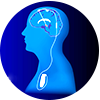The brain intervention relieved the patient of her hand tremors

Neurologists from the Neurological Clinic of the 1st Faculty of Medicine of the University of Prague and VFN in Prague and neurosurgeons from the Department of Stereotactic and Radiation Neurosurgery at the Na Homolce Hospital introduced a stimulation electrode to a completely new location in the brain for the first time in the Czech Republic. Before the procedure, the patient suffering from Parkinson's disease could not sign, drink from a glass, use a computer mouse or shake someone's hand. Post-operative results and first check-ups indicate excellent results that have changed the life of a sixty-two-year-old woman and almost freed her from difficulties.
Parkinson's disease is the second most common neurodegenerative disease. An estimated 30,000-50,000 patients live with this disease in the Czech Republic. The classic symptoms of the disease are rest tremor, stiffness, standing disorder and slowness of movements. "In the event that pharmacological treatment can no longer ensure optimal compensation of the movement state, we use deep brain stimulation in selected patients. We operated on our first patient in March 1998. Since then, we have been looking for new places that more effectively solve the specific problems of the patient. As in this case, when we implanted the stimulation electrode in a new target in the brain, for the first time in the Czech Republic," comments the head of the Neurological Clinic of the 1st Faculty of Medicine, UK and VFN, prof. MD Robert Jech, Ph.D.
Deep brain stimulation is a surgical procedure in which a stimulation electrode is introduced from a minimal approach and with millimeter precision into a selected core deep in the brain. The electrode is then connected by a connecting cable to a generator of electric pulses (neurostimulator), which, like a pacemaker, is placed in the subcutaneous tissue of the subclavian region.
The 62-year-old patient had the biggest problems with action tremor of the right upper limb, which, unlike resting tremor, is not typical for Parkinson's disease, although it can rarely accompany classical symptoms. "From the subthalamic nucleus, in which we normally implant electrodes, we probably wouldn't be able to influence such a tremor effectively enough," states the head of the DBS section from the Neurological Clinic of the 1st Faculty of Medicine, UK and VFN MUDr. Filip Růžička and adds: "Furthermore, action tremor was not well controlled by medication, so we had to find a target in the brain from which to affect both the classic symptoms of the disease and the action tremor of the right hand."
